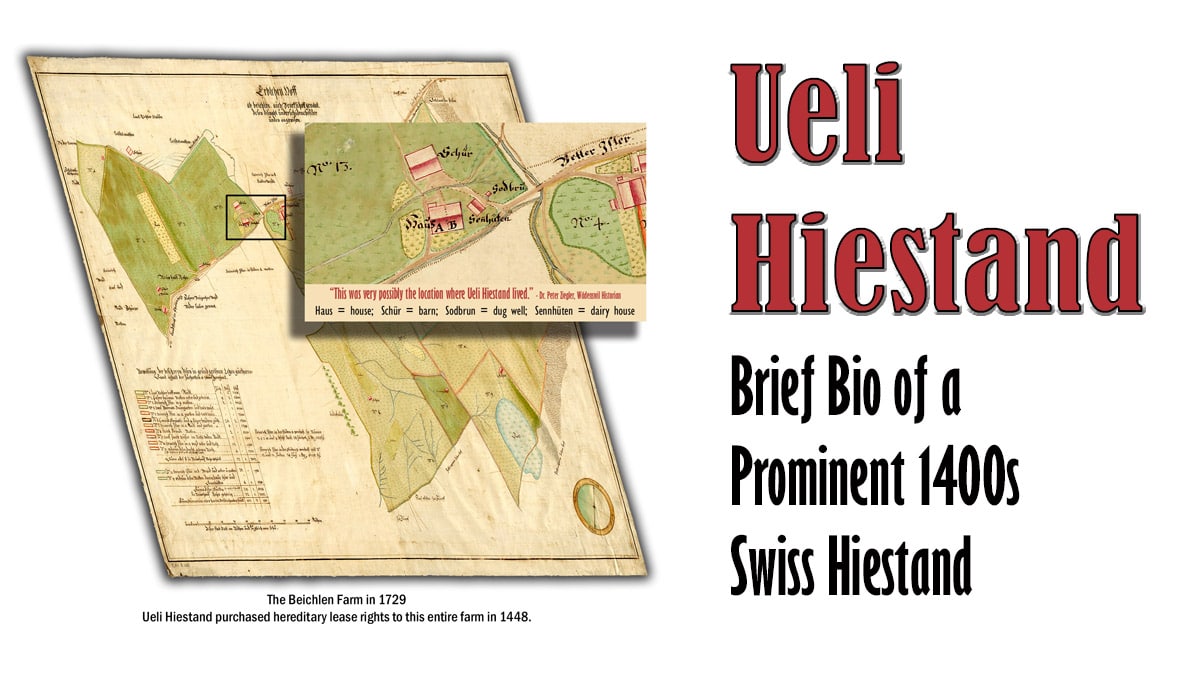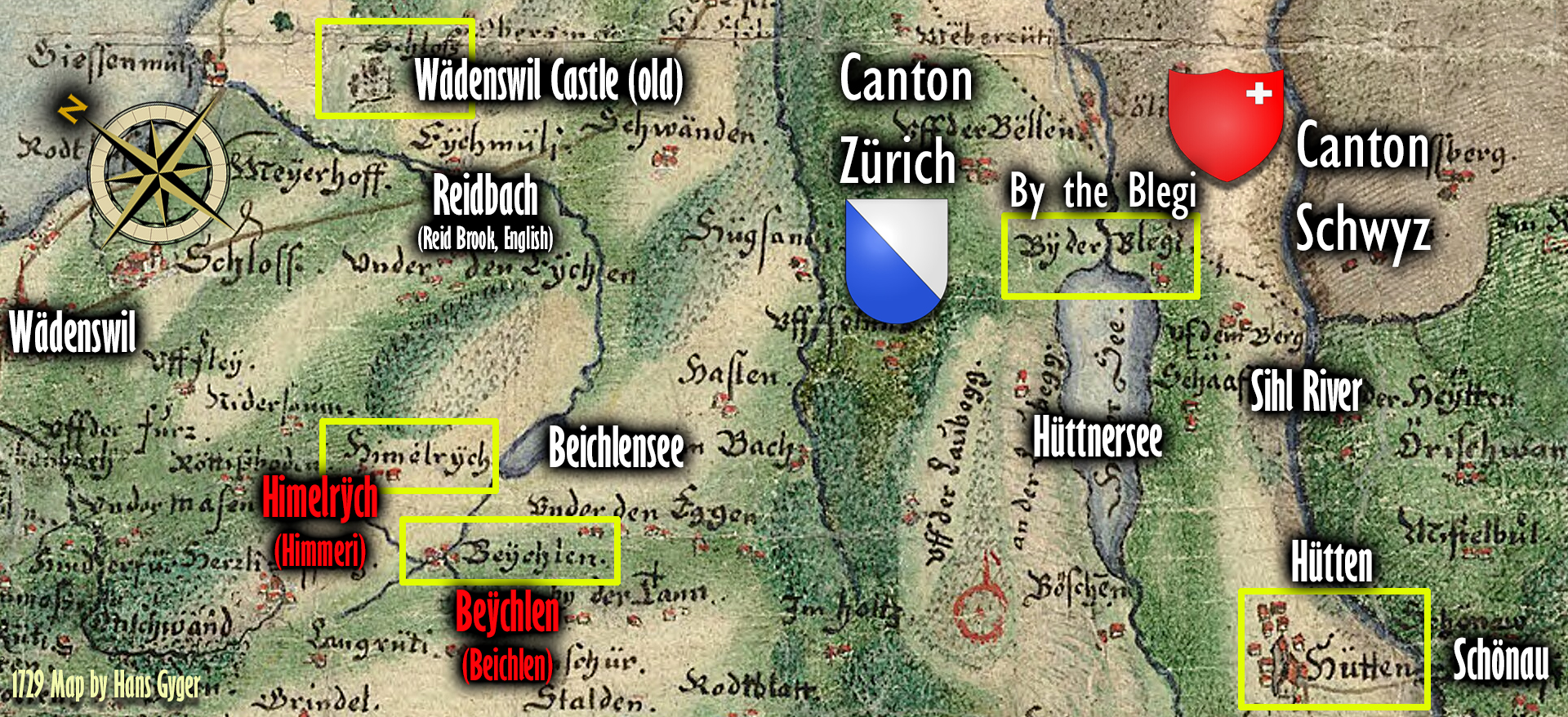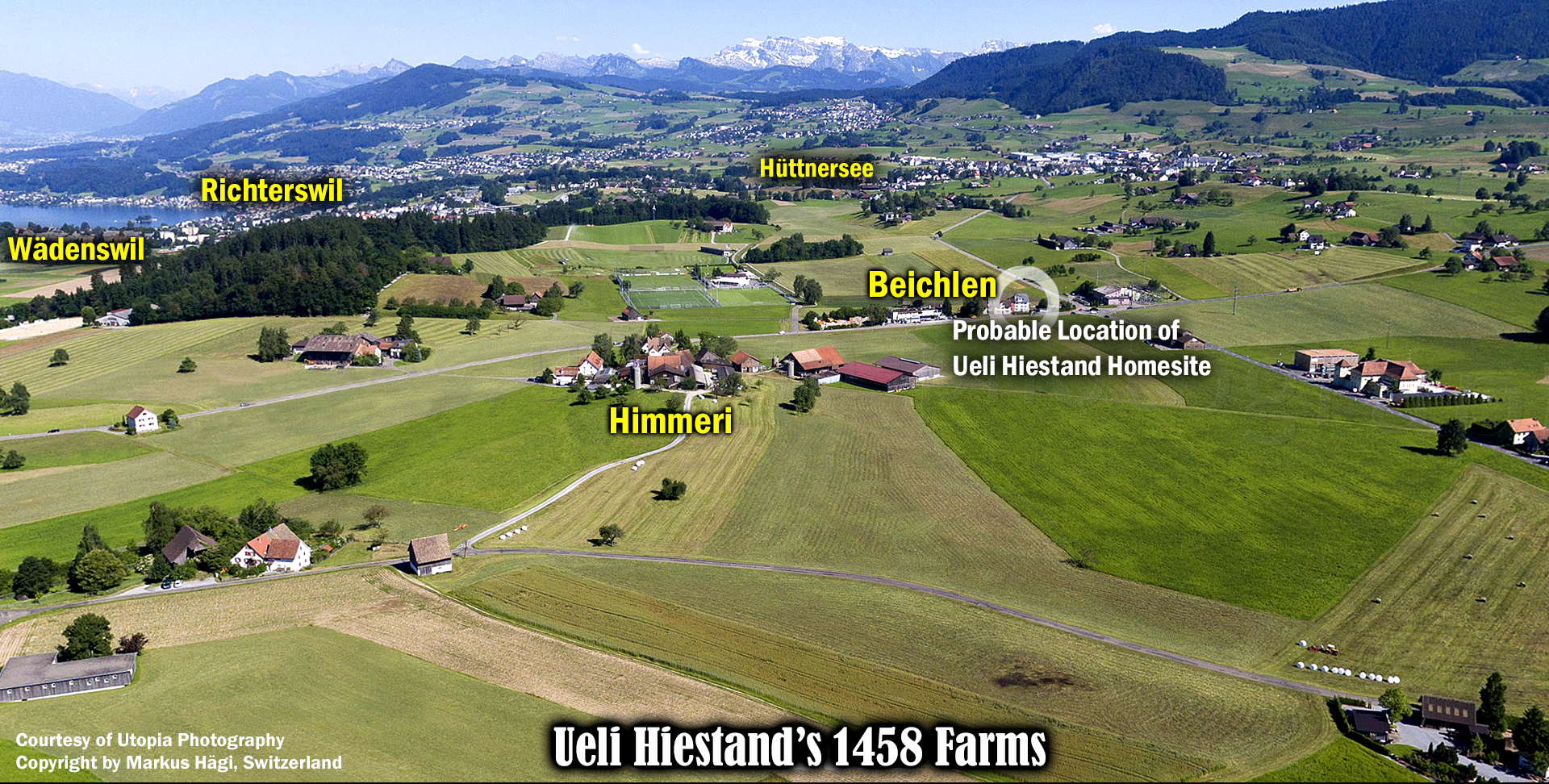Ueli Hiestand, Prominent Swiss Farmer in the 15th Century

Dr. Peter Ziegler (Zürich, Switzerland) and Dr. Wayne Haston (Pennsylvania, USA), Co-Authors
(Including significant research data from Kent Douglas Hiestand)
"Early Swiss Hiestands" Series
German Language Version of this Article
Can you imagine writing a biography of a relative who was living 600 years ago?! Well, here it is. And it is only possible because of a fantastic document repository like the Zürich State Archives in Switzerland and the able assistance of some very helpful American friends, who have spent more time researching Swiss Anabaptists than I ever will, and Swiss historians, especially Dr. Peter Ziegler, Wädenswil, and Dr. Nicole Billeter, Richterswil. To call it a “biography” may be a bit of an exaggeration, but there is enough information to give us a sketchy view of Ueli Hiestand, who was living in Switzerland’s Canton Zürich in the middle of the 15th century. So, I suppose I can call it a biographical sketch. -Wayne Haston
Ueli Hiestand, the Man
Ueli = pronounced oo-ELˊ-ee
In earlier years, families seem to have only used a few different first names and passed them on from generation to generation. It’s one of the genealogist’s greatest challenges. Heinrich and Jacob were popular names in the early Swiss Hiestand family. But the names Ruedi and Ueli and Kuni Hiestand also appear in Swiss records in the 1400s. The name Ueli Hiestand stands out as the most frequently mentioned Hiestand of the 15th century. It appears at least 12 times in the 1432–1458 Zürich state records, probably referring to one and the same person since it is a narrow timeframe. Apparently, Ueli was a leading citizen on the Wädenswil Berg and Richterswil Berg, the mountain slopes behind Zürichsee’s lakeshore villages, Wädenswil and Richterswil.
- January 30, 1432 (7429) – A Ueli Hiestand appears the first time (to my knowledge) in the documents available to me. He and Rudi Hiestand were witnesses to a lease of land from the Order of the Knights of St. John to Hensliy Kubischy.
- December 13, 1448 (9423) – See the summary of the 1448 transaction in the section below.
- November 30, 1449 (9491) – Ueli Hiestand witnessed a certification that Hans Urmer “has an interest of 1 pound of money from his house.”
- May 9, 1451 (9643) – Ueli Hiestant witnessed the certification of an auction. Ueli “and enough other respectable people” were present to witness the certification.
- December 20, 1457 (10272, 10273, 10274, 10275, 10276) – Ueli Hiestand witnessed five transactions on this day. In all these cases, he was mentioned first among “enough respectable people.”
- April 18, 1458 (10308, 10309) – Essentially the same as above, Ueli Hiestand and “enough other respectable people” were present to witness these transactions.
- August 29, 1458 (10333) – Again, Ueli Hiestand and “enough other respectable people” witnessed a transaction in the court at Wädenswil.
Several times Ueli Hiestand was referred to as a respectable person. I assume this means he was known as an honest and trustworthy person. Perhaps the mention of him as the first among “other respectable people” means that he was a leading citizen who was well-known for his outstanding character.
For me this is interesting, because it shows that the Hiestand family at the time were well thought of and trusted people. Not everybody was called as a witness.
Dr. Nicole Billeter, Historian in Richterswil
Ueli Hiestand's Farms, Hereditary Rights Acquired in 1448

Paraphrase of a translation of the original German document:
Ueli Hiestand was residing on the mountain slope behind the lakeshore village of Wädenswil. On December 13, 1448, Ueli presented documentation proving that Johans Loesel, Master of the Order of Knights of St. John in German Lands and Commander for the House of Wädenswil, had granted to him a hereditary lease to a farm in Benckli (later, Beichlen) and Himelrich (later, Himmeri), a farming estate. The annual lease fee was 14 Mütt and 2 Viertel (grain measures) of grain, 30 Schilling in Zürcher Pfenning (coins), and 2 chickens. The Benckli farm was located in the Wädenswiler Berg and bordered on Gepler's farm for fir trees, on the Bencklibach (stream), on the Geren (forest) and on the Eichwald (oak forest). The farming estate Himelrich bordered on the farming estate of Hartman ab Stolen and on that of Ueli Horger. Ueli was not permitted to divide the farms. He was allowed to cut the necessary wood for shingles roofing wood, but only at designated places. If he wished to give up the farms, he was required to pay 40 Pfund Pfenning (40 pounds in cash) and pledge all of his possessions as security.
C II 15, Nr. 145 from Zürich State Archives
After the Order of St. John cleared the mountain slopes above (behind) Wädenswil, rights to farmland were sold to some of the citizens. On December 1448, Ueli Hiestand bought hereditary tenant rights to lease two farms on the Wädenswiler Berg from the Commendam Wädenswil—a feudal estate (fiefdom, hereditary lease rights) owned by the Order of the Knights of Saint John (Johanniterorden). Beichlen (also Bennkli, literally means “steps/benches on a slope”) and Himmeri (also Himelrych, literally “elevated or particularly fertile land” ) were two of the oldest farms created from land cleared out of heavy forests on a plateau of Wädenswiler Berg known as Vorderberg.
In 1729 the size of the Beichlen farm (not including Himmeri) was 101 ¾ Jucharten, the same as when Ueli acquired the lease. The Juchart was a measurement of the amount of farm land that a man could work in one day, roughly about an acre. Unfortunately there is no existing record of the size of the Himmeri farm. Ueli Hiestand was probably one of the most prominent lease holders of the Order of the Knights of Saint John feudal estate in his day. Each year, on St. Martin’s Day, Ueli had to make a lease payment consisting of a certain amount of grain, 30 pieces of Zurcher currency and two chickens for rights to the Beichlen farm.


You will need to rotate the panorama to see the same basic view as appears above.
Red marker (on the Google map) where the Ueli Hiestand house was probably located.
If you appreciated this article, please share it with others who might also enjoy it.

Join Our June 2023 Hiestand-Haston Tour to Switzerland and Rhineland Germany

Have Mennonite or Amish Roots? - Participate in the DNA Research Project

